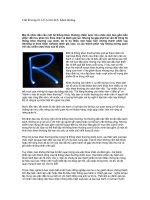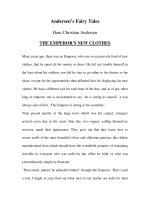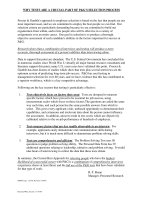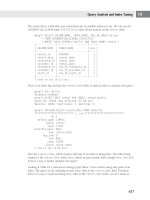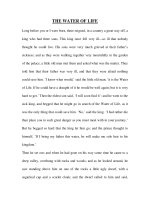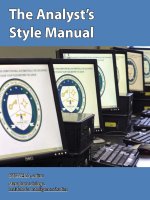Ryan’s Ballistic Trauma docx
Bạn đang xem bản rút gọn của tài liệu. Xem và tải ngay bản đầy đủ của tài liệu tại đây (15.97 MB, 747 trang )
Ryan’s Ballistic Trauma
Adam J. Brooks • Jon Clasper
Mark J. Midwinter • Timothy J. Hodgetts
Peter F. Mahoney
(Editors)
Ryan’s Ballistic Trauma
A Practical Guide
Third Edition
Editors
Adam J. Brooks, FRCS (Gen Surg),
DMCC RAMC (V)
Emergency Surgery and Major Trauma
Nottingham University NHS Trust
Nottingham
UK
and
Academic Department of Military
Surgery and Trauma, Royal Centre
for Defence Medicine
Birmingham
UK
Mark J. Midwinter, BMedSci (Hons),
MB, BS, Dip App Stats, MD,
FRCS (Eng), FRCS (Gen)
Academic Department of Military
Surgery and Trauma, Royal Centre for
Defence Medicine, University Hospital
Birmingham
UK
Peter F. Mahoney, OBE, TD,
MSc FRCA L/RAMC
Defence Professor Anaesthesia
and Critical Care
Royal Centre for Defence Medicine
Birmingham
UK
Jon Clasper, MBA, DPhil, DM,
FRCSEd (Orth), FIMC RCSEd, DMCC
Academic Department of Military
Surgery and Trauma
Frimley Park Foundation Trust
Frimley, Surrey
UK
Timothy J. Hodgetts, CBE, MMEd,
MBA, CMgr, FRCP, FRCSEd,
FCEM, FIMC RCSEd, FIHM,
FCMI, FRGS L/RAMC
Academic Department of Military
Emergency Medicine
Royal Centre for Defence Medicine
Vincent Drive, Edgbaston
Birmingham Research Park
Birmingham
UK
Associate Editor
John-Joe Reilly, BSc (Hons), GIBiol, PhD,
DIC, BMedSci (Hons), BM, BS
Academic Department of Military Surgery
and Trauma, Royal Centre for Defence
Medicine, University Hospital
Birmingham
UK
ISBN 978-1-84882-123-1 3rd Edition e-ISBN 978-1-84882-124-8 3rd Edition
ISBN 1-85233-678-1 (hardcover) 2nd edition ISBN 1-85233-679X (softcover)
First edition, Ballistic Trauma: Clinical Relevance in Peace and War (0340581144),
published by Arnold, 1997.
DOI 10.1007/978-1-84882-124-8
Springer London Dordrecht Heidelberg New York
British Library Cataloguing in Publication Data
A catalogue record for this book is available from the British Library
Library of Congress Control Number: 2011922047
© Springer-Verlag London Limited 2011
Every effort has been made by Springer to contact authors from the second edition of Ballistic Trauma
whose material has been used again and copyright holders of illustrations and photographs. Please con-
tact the publisher if your acknowledgment is incomplete so this can be updated in future editions
Apart from any fair dealing for the purposes of research or private study, or criticism or review, as permitted
under the Copyright, Designs and Patents Act 1988, this publication may only be reproduced, stored or
transmitted, in any form or by any means, with the prior permission in writing of the publishers, or in the case
of reprographic reproduction in accordance with the terms of licenses issued by the Copyright Licensing
Agency. Enquiries concerning reproduction outside those terms should be sent to the publishers.
The use of registered names, trademarks, etc., in this publication does not imply, even in the absence of
a specific statement, that such names are exempt from the relevant laws and regulations and therefore free
for general use.
Product liability: The publisher can give no guarantee for information about drug dosage and application
thereof contained in this book. In every individual case the respective user must check its accuracy by
consulting other pharmaceutical literature.
Cover design: eStudioCalamar Figueres/Berlin
Printed on acid-free paper
Springer is part of Springer Science+Business Media (www.springer.com)
John P. Pryor
†
This book is dedicated to John Pryor, trauma surgeon, mentor
and friend.
John died in a rocket attack during his second tour of duty as a
Combat Surgeon in Iraq on Christmas Day 2008.
He is missed.
Adam J. Brooks
ix
This Preface is being written at the joint UK–US Hospital in Helmand Province, Southern
Afghanistan.
Over the last few weeks the Hospital has received casualties from gunshot, burns, mines
and improvised explosive devices (IEDs). Adults, children, soldiers and civilians have all
been received and cared for according to clinical need.
The lessons from the third edition of Ballistic Trauma are being used here on a daily
basis. The third edition represents a blend of experience, best evidence and cutting edge
scientic research from DSTL. The Royal Centre for Defence Medicine is a focal point
where the three strands are blended and turned into practical guidance.
We hope that readers working in similar (and less extreme) circumstances will nd the
book helpful and to the benet of all their patients.
Adam J. Brooks
Peter F. Mahoney
Preface
xi
Why this book, why now?
In 1997 Prof JM Ryan and others produced the reference work “Ballistic Trauma:
Clinical Relevance in Peace and War” (Arnold 1997). Much of this is still valid but a num-
ber of concepts in care of the ballistic casualty have changed. These include developing
ideas on uid resuscitation and renement of eld protocols based on operational
experience.
Authors, editors and colleagues expressed the view that there was a need for a practical
guide encompassing these developments, along the lines of Conict and Catastrophe
Medicine (Springer 2002). The aim was to distill ‘real life’ practice and try to capture that
which is often lost or diluted in traditional texts.
Then with “9/11” the world changed. Since then major conicts have occurred in
Afghanistan and Iraq and operations are still on going. Many of the authors and editors
deployed to these conicts with NGOs, Aid Agencies and the military.
Others are working with these injuries on a day to day basis at one of the USA’s busiest
trauma centres.
This has delayed the production of “Ballistic Trauma-a practical guide” but means that
people are writing with recent experience of managing ballistic injury. Colleagues return-
ing from deployment have emphasised the need for clear guidance on managing ballistic
injury, especially as more and more military reservists are being deployed and their day to
day work may not include managing these types of injury.
Authors have been given a relatively free hand in structuring their chapters so they
would be unconstrained by the book’s style and able to pass on their lessons unhindered.
Finally our request is that this be a “living” document. Give us feedback. Record what
treatment works and what doesn’t. Use this knowledge to improve the care of the ballistic
casualty.
Peter F. Mahoney
James M. Ryan
Adam J. Brooks
C. William Schwab
Preface to the Second Edition
xiii
Ballistic Trauma: Clinical Relevance in Peace and War
This book aims to bring together the science behind and the management of ballistic
trauma. It is directed at the surgeon, though perhaps not an expert, who might nd him or
herself having to deal with patients suffering from penetrating trauma in environments as
diffuse as a late twentieth-century hospital or the arduous conditions of a battleeld.
The also brings together the views of UK and US experts from military and civilian
backgrounds. This composite view was deliberate as it was recognized that these poten-
tially diverse views reected the complexity of an international problem that increasingly
impinges on the practice of surgery in today’s world.
The UK editors were the joint professors of military surgery to the three armed services
and the Royal College of Surgeons of England along with a medical scientist with an inter-
national reputation in the eld of ballistic science. The US editor is professor and chairman
of the Department of Surgery at the Uniformed Services University of the health Sciences
and has extensive experience in the management of ballistic trauma.
Though the book is heavily inuenced by the military background of many of the
authors, it is directed at a much wider audience, particularly those who may unexpectedly
have to deal with the consequences of the trauma seen in an urban environment. It com-
pares and contrasts the differing civil and military management viewpoints and goes on,
where relevant, to debate the areas of controversy in the specialized elds of the relevant
authors.
The subject of ballistic trauma is controversial in part because its management depends
so much upon the situation in which it occurs. There is thus often confusion and a misun-
derstanding that emanates from the failure to recognize that the location of surgical facili-
ties, the numbers of injured and whether the injuries are sustained during peace or war may
have a profound effect on the way patients are treated. The lesson of history is that you
cannot take the experience of an urban hospital on to the battleeld. It can also be said that
you cannot do the reverse and nowadays there is further confusion from the deployment of
troops to “peace-keeping” duties performed under the scrutiny of the media. The latter is
not the same as war.
The book has four sections: the rst is on the science behind understanding ballistic
trauma; it also adds to its declared remit by including a chapter on blast injury; a second
section is on general principles of assessment and initial management; a third section deals
with management from a regional perspective; the fourth section is on more specic but
general problems. The intention is to provide surgeons with an understanding of the
Preface to the First Edition
xiv Preface to the First Edition
fundamentals of ballistic trauma, the mechanisms and some insight into the signicance of
new weapons, as well as the variations on the principles of management.
The book acknowledges that no single viewpoint can address the management of
patients sustaining ballistic injuries and does not fall into the trap of recommending rigid
and single guides unless there is a convergence of opinion. Its approach has been to pro-
vide a greater understanding so that the clinician facing the clinical problem feels suf-
ciently informed as to make coherent choices appropriate to the circumstances.
James M. Ryan
N.M. Rich
R.F. Dale
B.T. Morgans
G.J. Cooper
xv
Illustrations provided by Corporal Anthony W. Green.
Corporal Green studied Art at North Oxfordshire College of Art and Design, after
which he studied Journalism at University of Derby. He has written a number of books
including the history of his own Territorial Army medical unit entitled “A Jolly Good
Show”. He has served with the Territorial Army for 10 years. This service has included
tours in both Iraq and Afghanistan.
All illustrations contained within this book were made while he was serving with the
UK JF Med Group Role 3 Hospital at Camp Bastion on 2009.
Jillian Staruch is a student at The Pennsylvania State University. She will graduate with
an Architectural degree in 2012. As the youngest of ve, she enjoys spending time with her
family and freelances in graphic design.
Figure 18.3 and 28.2 drawn by Dan Miller. He works as a freelance graphic artist in
the UK.
Acknowledgements
